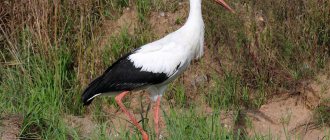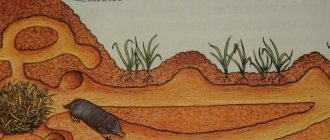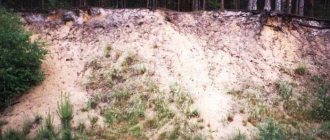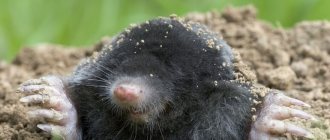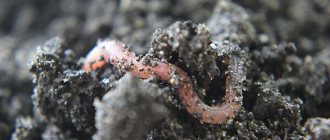Many summer residents and gardeners associate moles only with the appearance of a large number of ugly piles of earth in carefully tended beds, as well as with regular damage to various root crops - carrots, beets, potatoes, onions... And if you ask, for example, a lover of outdoor activities in the country, what If a mole eats, then many would answer that, in fact, it eats these very vegetables - carrots, potatoes, and sometimes it doesn’t disdain garlic.
In general, the food preferences of moles are often attributed to everything that is damaged in one way or another during the life of these animals on the site.
At the same time, even schoolchildren who are little familiar with gardening know well that the mole is a predator, and it feeds mainly on insects and earthworms.
This is a certain contradiction associated with the idea of what exactly moles eat: book and scientific theory says that moles feed on invertebrate animals, but garden practice seems to clearly show that moles eat underground parts of plants.
What is the truth here? Everything falls into place if you understand not only what moles eat, but also how they do it...
Why landowners don't like moles
Moles are small, active creatures with tiny eyes and powerful paws. The color of the skin ranges from light brown to black. They live everywhere: on the edges of forests, in gardens and vegetable gardens. They dynamically dig complex labyrinths in the ground at a depth of 20-30 cm. But it is at this height that the root system of most flower crops and annual vegetables is located. Because of this, people have a conflicting attitude towards these animals. They prefer loose soil, as it is easier to dig holes in it. They are more often found in dachas located near forest belts. Consequences from the actions of animals:
- Moving along its underground passages and digging holes, the animal thus provides itself with food. But for humans, these food labyrinths create a problem, since small agricultural tools fall into them and fall underground. Lawn mowers sometimes even get into such holes.
- The decorative quality of lawns and flower beds decreases when freshly dug earthen mounds grow among the flowers.
Most landowners are confident that neither small rodents, nor moles, eat the root system of plants. But this opinion is erroneous, since the animal’s intestines are not capable of digesting such food, and the teeth are not adapted to chew it.
The structure of the digestive tract
A study was conducted that showed that the animals mainly eat invertebrates. Scientists caught animals, dissected them and studied them. The following were found in the stomachs:
- earthworms are the most preferred food that the animal consumes most often.
- slightly less larvae of beetles and insects.
- 3% - centipedes, mole crickets;
- 1% – grain crops and plant parts.
The summary showed that moles rarely feed on green vegetation. They prefer a meat-based diet and are insectivores. In connection with the conclusion, it was confirmed that:
- The digestive tract of predatory species is completely similar in structure to the digestive system of the mole. The animal's chewing teeth are weak, the canines with incisors are strong and sharp. The length of the intestine is short. At the same time, the animal has a fast metabolism, and this is typical for individuals that eat meat.
- The muskrat (Desmana moschata) and the shrew (shrew) are mammals from the mole family and are the mole's closest relatives. These are voracious predators whose main diet is meat. And given that it belongs to this family, it turns out that the mole also eats meat.
If you look at it, the shrew is a distant ancestor of the mole, which completely switched to underground life. But for a long time his eating habits have not changed. Moles eat the same things that shrews once ate.
Mole's favorite food
Indeed, moles eat mainly invertebrate animals, with earthworms making up the largest part of their diet. This is a fact proven by specially conducted research: scientists caught animals with mole traps, opened the carcasses and then studied the contents of the stomachs.
According to the results of such studies, the following were found in the stomachs of moles:
We conclude: moles eat mainly earthworms and insect larvae, and also slightly diversify this delicious meat diet with coarser adult insects and various invertebrates, and very rarely eat parts of plants.
In general, these studies only confirm other scientific data. For example, these:
Indeed, the smallest carnivorous mammals on the planet turn out to be the most voracious, if you correlate their body weight with the weight of the food they consume. For example, a shrew, weighing only 5-6 grams, consumes as much food per day as it weighs. If she were the size of a lion, she would need at least 100-150 kg of meat per day. Fortunately, biological laws prevent such voracious creatures from becoming large, and large predators from being such active eaters.
To put it simply, a mole is the same shrew, only it has switched almost completely to an underground lifestyle. But this transition did not affect food preferences in any way - moles eat everything that their common ancestors with shrews ate.
At the same time, the mole eats mainly earthworms not so much because of their unique nutritional value or taste, but because of their abundance and prevalence in the fertile layer of the earth. The animal is constantly moving in its underground tunnel, or digging a new one, and at the same time catches and immediately eats everything that comes in its way. If you come across an earthworm, it will eat it; if you come across a slug or centipede, they will also go for a “snack.”
Of course, a mole’s diet varies somewhat depending on what biotope it lives in and what soils it digs its burrows in. For example:
The hunting grounds of moles can be located on the borders of different biotopes - part can be located under a tree grove, another part - in a forest clearing or under a field. The inhabitant of such a site can significantly diversify its diet, moving either under the roots of trees or onto oily, plowed and fertilized cultivated soil.
However, the predatory nature of moles is far from limited to worms, insects and their larvae. Few people know that if a mole has the right opportunity, he does not disdain almost anything that moves and consists of flesh...
Additional tips and tricks
Combinatoriality is important in catching moles. A combination of different types of traps will give maximum results.
If you want to catch an animal alive and unharmed, it is extremely important to use hard gloves when working. They bite hard
It's painful and unsafe. It is better for the catcher to take his trophy away from home, at a distance of at least two km. In this case, he will not find his old moves.
If there are a lot of moles in the region, then it makes sense to spend time and money, but solve the problem radically:
- Dig a lawn net throughout the area. To do this, remove about 15 cm of soil around the entire perimeter, lay a mesh and then return the soil.
- A similar preventative method, but the mesh is dug in around the perimeter to a depth of up to a meter deep and about 30 cm of mesh should remain on top of the ground.
- As an option, trenches are dug around the perimeter, which are concreted or filled with coarse gravel, parts of bricks, and crushed stone.
In any bad news there can be good moments. Experts say that moles are picky and will not settle on infertile land. So, if “guests” appear at the dacha, it means that the earth is full of vitamins and minerals. All that remains is to send out the uninvited comrades and start planting seeds for the future harvest.
Where does the mole live?
Photo: Soil animal mole
Representatives of the mole family are widespread. They live throughout Eurasia and North America. In South America, moles are completely absent. Scientists have concluded that these animals settled in North America when it was separated from the South by the Strait. Moles live in especially large numbers in Russia, Belarus, Poland, Ukraine, Georgia, and Moldova.
In particular, four species of moles live in Russia:
- Blind. It is distributed from Ciscaucasia to Transcaucasia. Representatives of this species can often be found in Turkey and even in Northern Iran. The animal lives in mountains, alpine meadows, and is sometimes found in forest landscapes. To live, blind moles choose loose, moist soils. Sometimes these animals live together with the Caucasian species;
- Caucasian. It settles in the central, western parts of the Caucasus, and is found in some areas of Turkey, which are adjacent to the shores of the Black Sea. Caucasian moles live mainly in deciduous forests, but in small numbers they are found in mountain meadow biotopes. In search of food, such animals can go to a depth of up to one meter. The main passages are located quite close to the surface - at a distance of five centimeters;
- Altaic. It has a uniform coat color, the fur on the belly is matte. The appearance of Altai moles is completely consistent with moles. The body of the animal is quite massive and round;
- Ordinary. This is the group of the most common moles. Its representatives can be found in various landscapes: from forests to mountains.
For a normal life and reproduction, moles need special conditions. For this reason, they choose areas with moist soil. It is most suitable for digging tunnels. The terrain of the area can be almost anything. The animals prefer a moderate climate.
Effective ways to fight
Since the activity of a mole on the site will allow you to effectively get rid of many harmful insects, it is logical that you need to get rid of the animal itself after it has performed useful work. In this case, it is better to choose control measures that expel, rather than kill, the mole. After all, this may turn out to be a Red Book species.
You can get rid of a mole in the following ways:
- The most effective and simple way to combat it is to plant plants in the garden that have a strong odor. Such plants can be tagetis, celery, hyssop, basil, dill, etc. These plants need to be planted in small groups, but throughout the entire area. 1.5 months after planting, they will begin to emit an odor and the moles themselves will leave your “hospitable” garden;
- You can remove these animals by burying waste from salted herring (spoiled fish, entrails, heads, etc.) at the exit from their burrows. But this method of control is less effective, since after the fish waste has completely decomposed in the ground, the animals will return. Then you will have to get rid of them again.
Another method of control is to transplant daffodils. It's all about the smell again. Moles cannot tolerate it and therefore will very quickly leave your summer cottage. They need to be planted near mole holes. A positive result will be noticeable within a couple of weeks.
A less effective control method is the use of mole traps. This product will help get rid of animals quite quickly. But moles also quickly learn to get around such obstacles. Today there are several types of such traps. They are small tubes with caps on both sides.
Another tool often used in gardens to combat moles is a mole trap or traps. The animal will not be able to get out of such a device on its own. But the question here is different: how to install a mole trap in holes? To install, you need to remove the top layer of earth near the hole. We install the trap in an open form. Remember that installation should only be carried out while wearing gloves. Otherwise, the animal will smell your scent and avoid the trap.
In addition to the methods described above, some gardeners suggest using special “repellents” to protect against moles. Their operating principle is to generate a variety of loud sounds. Such “repellents” can be made with your own hands in the form of rattles, plastic bottles and various noisemakers. But this remedy is actually practically ineffective, although it is popularly known as an “excellent method.”
Folk methods of struggle include:
- use of reeds. Its length must be at least 2 meters. Clean the insides of the reeds and insert a tube into it. Bury the resulting structure in the ground, leaving 60 cm above the ground. With the help of the wind, the reeds will create a sound that scares away animals;
- the most difficult way is to dig hard material (slate, linoleum) into the ground. You need to dig it in to a depth of 70 cm. As a result, you will get a physical barrier against moles;
- flooding holes with water.
Another means to effectively combat moles is the use of various poisons. There are several types of poisons available on the market. Before using such products, be sure to read the instructions for use.
Please note that if you completely destroy the entire mole population within your area, in a couple of years you will suffer from an invasion of mole crickets, chafers and other insects that will not only damage your crops, but infect them with various diseases. So moles, compared to this “happiness”, will seem to you the lesser of evils
Therefore, in a situation where you need to get rid of moles, it is better to choose non-radical methods of control.
We drive away the mole with sound repellers
As already noted, moles have excellent hearing and sense of smell. These features are often used to drive away unwanted guests. Sound repellers are the most common method. They can be either homemade or purchased.
The first ones are easy to make from plastic bottles. We cut out U-shaped windows in a circle and bend them to form wings. We put the device bottom up on a metal pin driven into the ground. The wind will spin the bottle and it will make a crackling noise.
The second are devices that generate microwaves. Manufacturers assure that such discomfort leaves moles with no choice but to look for a new habitat.
How to drive a mole out of the garden using folk remedies?
It is possible to build or prepare an effective remedy for moles in the garden, and this can be done in several ways. Some summer residents appreciated the method of expelling an uninvited guest by influencing his delicate sense of smell. Others managed to solve the problem with vibration and noise effects. The latter are made from improvised means or purchased ready-made:
- A jar with a cheap Chinese watch is buried in the ground at the level of the mole tunnels. Alarms are set for different times; it is advisable to bury more cans to make the animal as uncomfortable as possible.
- You can bury an ordinary glass bottle, leaving its neck above ground level. The tilt angle is 45°, then there will be a hum when the wind blows inward.
- Plastic will become an assistant for a summer resident in how to deal with moles in the garden. They are buried or buried, covered with lids. As temperatures change between day and night, the air contracts and expands, creating a characteristic crackling sound.
It’s even easier to use the animal’s delicate sense of smell, because the list of odorous agents can be expanded indefinitely with the development of the chemical industry:
- The classic recipe for fighting a mole is burying rotten fish. After the characteristic amber appears, the fish is buried in pieces or whole in the feeding surface tunnels.
- Technical fluids, calcium carbide, even acetic acid are poured into the ground. The scents will scare away any animal, but it would be a stretch to call such methods humane. Killing an uninvited animal, and even harming the soil, is a desperate option to solve the problem.
- Another popular and dubious way to fight is to smoke out the mole with car exhaust. Some even use smoke bombs. If you are going to literally smoke a mole, then resort to ready-made balls with the scent of lavender.
Ammonia for moles - use in the garden
The smell of ammonia will repel any living creature. As expected, ammonia was on the list of tips on how to get rid of moles in the garden. The characteristic mounds from the tunnels are advised to move and find the entrance to the hole. Place cotton wool in it, generously moistened with ammonia, and dig in. Moles have an extremely negative attitude towards this smell and leave the area. You can make a hole in the cork and bury the bottle at an angle directly into the tunnel.
Birch tar in the garden against moles
The list of how to drive a mole out of the garden using odors will be complemented by the method with birch tar. Animals do not like this characteristic aroma, but it does not harm the environment at all. We stock up on pegs and cover them generously with tar. Next, we stick pegs around the perimeter or in the area where the mole is spotted, in a checkerboard pattern at a distance of three to four meters. The smell will repel the animal for about three months, after which you will have to re-treat the pegs with tar.
Forest life
A mole's diet in the wild is much more varied than in human-cultivated areas, where insect pests and worms mainly live. In the forest, the animal prefers to eat:
- flies;
- wasps and bumblebees;
- ants;
- various bugs, their eggs, larvae.
In addition, the animal catches small snakes, frogs that are found in the meadow, and lizards.
Sometimes large poisonous spiders become the prey of a mammal if they do not have time to escape from it.
Food in winter
In winter, mammals do not hibernate, but continue to build labyrinths and search for food. Moles feed in winter:
- Regardless of seasonality, their nutrition is the same. Only some food objects in the ground change. Most of the beetles, which are abundant in the summer, die in the fall, and the ants try not to leave the anthill. Therefore, it is almost impossible to find them in winter.
- In winter, the animal eats pupated butterflies and beetles. Sometimes he comes across hornets and wasps hibernating in the ground.
- Although living conditions worsen with the onset of cold weather, the animals do not change their habits. They continue to eat earthworms, which they stocked up in the summer. Having caught an invertebrate, the animal bites off its head and then eats it. The rest remains in storage areas “in reserve”. During the winter, some worms burrow deep into the soil and go into suspended animation. The animal can always dig them up and feast on them.
- Voles and shrews tolerate winter cold much more difficult. In search of food, they end up in tunnels, where they die from the claws of a mole.
At the end of winter and early spring, most moles die. This is due to lack of nutrition. Due to its fast metabolism, moles need to eat constantly. If he does not find any living creatures in a day, he will die of hunger.
Who eats moles?
In turn, moles themselves often become victims of other predators. They are actively hunted by birds of prey (harriers, buzzards, eagles, owls), as well as foxes, wolves and dogs, martens. Young individuals are even eaten by weasels, which actively climb into mole holes in search of owners.
At the same time, some predators eat moles only in times of famine, since the animals smell strongly of musk and do not have a pleasant taste. This is partly why moles are not eaten in any cuisine in the world, even in China, where, it would seem, they can cook kebab from anything.
In nature, animals and birds that feed on moles can catch the animal, kill it, but, feeling the smell and not being hungry, they leave them at the place of capture. The same often happens with shrews, which have an even more unpleasant odor.
Interesting video: a mole catches and eats first a lizard and then a frog
Why do I get rid of a mole in the garden?
On my site, moles (mole rats in common parlance) settled only once - I can say that this became a big problem. Their active underground activity ruined many plantings, the cultivation of which I spared neither effort nor time. In addition to annual seedlings, moles damaged the roots of cherry trees, apple trees, pears - some plantings died, others I took a long time to treat and nurse.
There is a lot of harm from mole rats:
- By digging numerous and intricate passages, they damage the root system and spoil root crops. But they feed exclusively on insects: such pestilence is a “side effect” of their underground movements.
- Moles dig large holes on the surface of the ground, which also damages plantings and spoils the appearance of beds and lawns. Such sabotage is also dangerous for humans - you can easily twist your leg in a molehill hole.
I recommend that you “know the enemy by sight.” Shrews, useful for the garden, which actually destroy underground insect pests, are often confused with it. These animals do not dig large underground passages and do not harm plantings.
mole in the garden
From experience I will say the following:
- Independent control of moles is effective only in one case - with an integrated and consistent approach. Exploding a few firecrackers or burying rotten fish heads in the garden is not the answer. This will only fix the problem for a short time.
- For effective control, you should not only catch moles, but also install repellers, as well as barrier products that will prevent new pests from entering your garden.
- The more methods and means you use, the more likely it is that the area will be freed from mole rats.
I know firsthand how annoying moles are - such sabotage destroys all compassion for them. And yet I tried to use humane means - repelling, and not destroying, underground inhabitants. He released the caught moles into the wild - he took them to the forest, to the field, from where they would not reach the garden plots.
All the ways to catch a mole
Generally speaking, today the following popular methods of catching moles in the garden and dacha are most widely used:
- The so-called mole trap is a pipe into which the mole crawls, but can already get out;
- A pit trap into which the animal simply falls, moving along its underground passage, and then cannot get out of it;
- Traps that kill animals immediately or slowly (this also includes a wire mole trap);
- Tackle made of fishing line and fishing hooks: the mole clings to the hook either with its skin (skin), running into itself while moving through the tunnel, or with its mouth, collecting earthworms strung on fishing hooks (and this is just one example of the flayer approach to catching moles);
- Perhaps it is also worth mentioning an ordinary shovel - with the proper dexterity and experience, with its help it is possible to dig an animal out of the ground alive, and then, for example, place it in a bucket.
It is noteworthy that the effectiveness and ease of use of all these options is approximately the same (with the exception of fishing with a shovel - this method is the least effective and requires a lot of time). Any trap is simply installed in the garden, catches the mole in one way or another, and the gardener can only check from time to time for the presence of a “catch”.
Accordingly, the question arises: if a live trap catches a mole as simply and quickly as a mechanism that pierces the animal with a knitting needle or breaks its back, then why use lethal traps at all? Unfortunately, in many cases, the answer lies in the gardener’s banal laziness - he’s just too lazy to carry the caught moles a kilometer away from the plot every time, because it’s much easier when the trap “delives” a ready-made corpse, which is easy to dispose of, for example, by burying it in the far corner of the garden.
Methods for controlling moles on the site
Digging in the mesh
It is better to protect yourself from moles before they appear. To do this, a fine mesh made of metal or plastic is dug in along the entire perimeter of the site to a depth of 0.5–1 m, with a protrusion of 15–20 centimeters above the ground surface. Perhaps the only drawback of such a means of protection is the laboriousness and duration of the process of burying the mesh itself.
Such a mesh should be dug into the ground along the perimeter of the site to a depth of 1 m and with a protrusion above the ground surface of 20 cm
Catching using mole traps
A mechanical method of dealing with an already existing problem involves the use of a special device with bait - a mole trap. It could be a noose, a crossbow or a trap. This method is suitable for a small number of animals. Mole traps can be found in most garden stores or markets.
If there are a small number of moles on the site, then a mole trap would be a good remedy.
Tunnel mole traps are also gaining popularity. They look like a plastic pipe with traps at the ends. But to get the expected result, you need to install it correctly. It is better to place the device at the top of the hole and cover it from above to make it invisible.
It is important to correctly install and camouflage the tunnel mole trap on the surface of the earth
Video: review of mole traps
Repellent
All kinds of “repellents” are one of the most effective methods for mole infestations. They can be ultrasonic, sonic and aromatic. Ultrasonic devices can be found in specialized stores. They are safe for humans, easy to use and do not produce any extraneous sounds. Before use, you must carefully study the instructions and strictly follow them for the best result.
The most reliable device for fighting moles is an ultrasonic repeller.
Sonic repellers can be easily made at home using a variety of materials. For example, a buried open bottle with its neck up, which creates a humming sound and microvibration of the soil, or columns with tied cans.
Smells that moles don't like
Since moles, deprived of vision, have a sensitive sense of smell, they can be driven away with the help of odors. Animals run away when they smell odors such as kerosene, castor oil, tobacco, fuel oil or antifreeze. It is enough to soak old rags in the solution and put them in the holes. Some plants also repel pests, such as garlic, beans, peppermint, onions and wormwood.
To get rid of moles, you can plant garlic around the perimeter of the area.
Poisoning is an unsafe method
The fastest-acting method is the use of chemicals. At the moment, there are many poisons available to combat moles. Before using the selected chemical, you should be sure to read the recommendations for use, since some poisons can have a detrimental effect on any plantings in the area in which the treatment will be carried out. Considering these facts, it is not advisable to use this method in the garden.
Today, a number of products are produced to combat moles
Biological method
As an option, a biological control method should be considered. To do this, eliminate the mole food supply using products that destroy insects and worms. When pests do not find a food source, they will simply lose interest in the area and leave it in search of food. But it is worth considering that this method can harm the soil, so you should be extremely careful.
Oddly enough, pets can also be useful. For example, dachshunds are capable of exterminating a considerable number of moles and forcing them to leave the area.
One of the features of the Dachshund breed is that these dogs can catch moles.
What do moles eat? What do they need from your garden?
A mole is a small fur-bearing animal with small eyes (which are almost invisible) that lives underground. Another distinctive feature of moles is the presence of wide and slightly turned to the sides five-fingered forelimbs with powerful claws. With their help, he breaks through numerous passages in the soil - feeding routes, sometimes reaching hundreds of meters, but you will find out what moles eat in your garden later.
How does a mole live in nature?
There are people who believe that moles are vegetarians and burrow into the ground solely in search of plant roots. In fact, in nature these animals are real predators. They feed on earthworms, beetles, flies, wasps, mole crickets, ants and various larvae found in the ground. They can even cope with mice, small snakes, lizards and frogs that find themselves in a hole.
Moles get their food this way: they build a whole network of branched passages, then constantly move along them, picking up prey that they find.
When digging underground passages, the animal expends a lot of energy, so to compensate for it, it is constantly looking for food. The weight of insects, worms and larvae eaten at one time is about 30 g, and over the course of a day it is almost equal to the weight of the mole’s body.
In addition, he drinks a lot of water and stores earthworms for the winter. It is active throughout the year, making feeding passages even in winter. Worms crawl into them, attracted by mole musk and higher air temperatures.
Mole on a garden plot or dacha
Despite the fact that moles do not feed on any plant food, including plant roots, their appearance in a garden or summer cottage causes significant harm. Unlike another underground inhabitant - the mole rat (in the photo on the right) - they do not eat potatoes, carrots, other root crops and vegetables, but undermine them. The root of a plant, falling into the path of a mole, loses contact with the soil, which inevitably leads to its death.
Factors that determine the attraction of moles to garden plots, vegetable gardens and summer cottages:
- The soil here is loose, moist, and more favorable.
- Availability of sufficient food, including earthworms.
- Moles become less noticeable because the excavated soil is not thrown to the surface, but is pressed into the walls of the passage.
Branched mole tunnels can damage the roots of berry bushes, trees and vegetable crops. However, if moles appear rarely and they do not cause significant harm, you can ignore them, but otherwise, you need to get rid of the moles.
To protect these animals, we can say that moles are not pests like locusts or the Colorado potato beetle; they also bring considerable benefits to agriculture. Their underground passages loosen the soil, improve its moisture and ventilation. In addition, forest plantations are freed from pests such as insect larvae, snails and beetles.
A little about the mole’s nutritional “culture”: when, how and how much does it eat?
The mole eats a lot and often. During the day, he eats about 5-8 times, crawling out of the nesting chamber in which he rests, and for a very long time collecting food in the feeding passages.
Between meals the animal rests and sometimes sleeps.
On a note
Digestion of a portion of food lasts about 4-5 hours for a mole. After this time, the animal becomes hungry again, and after 16-17 hours, if it does not find food, it weakens and quite quickly dies from hunger. Thus, the mole literally needs to constantly eat.
In one sitting, a mole eats about 15-20 grams of food, and in a day - about 50-60 grams. As a rule, he needs an amount of food per day that is 60-70% of his body weight, although in times of hunger he can “get by” and 20-30%. And on “fat” summer days, while fattening up, the animal can eat as much as it weighs.
It is also useful to read: Is the mole really blind and sees nothing?
It may seem that the mole eats a lot (if a person consumed the same amount of food in relation to his weight, he would have to eat 40-50 kilograms of meat per day). Such gluttony of animals looks fantastic, but from a scientific point of view it is quite easily explained:
- Moles have a very fast metabolism. This means that the food consumed is converted into energy or fat reserves in their body within a few hours. After this, the animal needs to eat again;
- Moles are very active and spend a lot of energy. Only those who have not seen them might think that they are clumsy, slow animals. In fact, the mole is very fast, and if it does not sleep, it is constantly in motion, which means it constantly wastes energy that needs to be restored;
- In search of food, the mole does a lot of hard work, so to speak. Figuratively speaking, his energy investments in searching for food are very large, and in order to at least “beat them off”, he needs to eat a lot. To understand this statement, imagine that in order to get a portion of food you need to dig a hole in the ground with a diameter equal to the width of your shoulders and a length of about a meter. Also imagine how much energy you will spend on this and what the portion of food should be in order to at least restore strength after such work;
- Due to the small size of the mole's body, heat transfer in relation to its mass is significantly higher than that of larger animals. This means that, constantly staying in cold ground, an animal needs more food to maintain body temperature than, say, a person or a dog.
When feeding, the mole sometimes simply moves along the passage, picking up its victims in it, and when it is full, it moves into the residential passage and rests there. If necessary, the animal begins to dig new passages.
In winter, the mole requires slightly less food than in summer, due to which it can survive in conditions of a reduced amount of food.
There are no pronounced fluctuations in daily feeding activity in moles. Except that at night the animals more often dig new tunnels and come to the surface, so at night they consume less food. But in general, these animals eat and rest approximately evenly throughout the day.
Main varieties
The classification of moles implies the existence of over 40 species. Among them, the most common are about one and a half dozen subspecies.
East Asian
Animals from the Mole family. They are found in mid-mountain meadows and forests of East and Southeast Asia. Little studied, do not have well described characteristics.
Mogers
Moles with a body length of 9–25 cm and a weight of 290–300 grams. They differ from their relatives of other species in their brownish-brown hair, the specific structure of the auditory apparatus and pelvic bones. There is no fang in the lower jaw. The eyes are covered with leathery membranes and are not visible from the outside.
Ordinary
The animal is known as the European mole. It has a rounded oblong body, an elongated muzzle and a short neck. The limbs are small, adapted for digging. The front legs end in spade-shaped palms that are turned outward. They have powerful claws.
American shrew
The most popular species of mole in North America. Their habitat is wet areas. They have soft and dense fur. The tail is long, equal to half the body. The length of the animal itself is about 10 cm, weight – 10 grams. The eyes are small, the paws are less adapted to digging than those of other subspecies. The animal can swim and climb bushes.
Hairy-tailed
Another American-Canadian species of moles. The animals weigh 50 g and have a body length of 3.5 cm. The head is strongly elongated. The upper incisors are better developed than the other teeth. The animal sometimes crawls out to the surface of the ground at night.
Whitetail
A representative of Moles, distinguished by its white tail. In general, it looks almost like all other moles. Found throughout Bangladesh, India, China and Myanmar.
Eastern American
A large mole, 16 cm long and weighing 75 g. The front legs are wide and powerful, well suited for digging. There is no hair on the paws. Their width is greater than their length, the hind and front toes are fused.
Types of moles and other digging animals
The garden (country) mole is a fluffy little animal with beautiful, soft shiny fur that grows straight and has no direction. This allows the mole to move underground in any direction without feeling discomfort.
The body is elongated, elongated, measuring 10-12 cm, sometimes 16-18 cm, weight 75-120 g. With this size, the animal is very gluttonous, consuming food twice its weight. Therefore, he is constantly in search of food.
This quality is useful because the mole feeds on garden pests:
- May beetle larvae;
- mole crickets;
- beetles;
- wireworms;
- earthworms.
Depending on their habitat, moles have several varieties. They differ in color, size and dietary preferences.
Types of moles:
- European black mole. Widespread, found in Europe, Asia, America, Canada, Mexico, Ukraine, Polesie, and the Carpathians. The animal chooses fertile lands, with rich vegetation and an abundance of insects. The mole can also feast on lizards, small mice, and frogs. The animals do not hibernate, they are active all year round, only in winter they go into deeper layers. Burrows are dug at a depth of 5 to 50 cm, and the nest is made between the roots of large trees or stumps at a depth of 1.5 meters. Life expectancy is 5 years.
- There are two types of moles in the Caucasus: the Caucasian mole and the small Caucasian mole. Their sizes are small, about 11 cm, and their weight is 30-100 g. Otherwise, they are similar to the European one.
- The forest mole (Altai) lives in Western and middle parts of Siberia, Yakutia, and Altai. It is scarce because until 1960 it was mined for its beautiful skin. It feeds on shoots, seedlings, buds of trees and shrubs.
- The field mole is unique, has a gray color, feeds on shoots and roots and is a rodent, not a mole. In Scandinavian countries it is called a mole, although it is more like a mouse with a blunter muzzle, short legs and tail. Lives 1-2 years.
Who else digs holes in their summer cottage?
Often it is not the mole that digs in the area, but other rodents. You can determine which animal has worked in the garden by the shape of the dug passages. Mole burrows are distinguished by the presence of a hill of earth - a molehill. The passages for searching for food break through at a depth of 5-10 cm and form a loosened furrow on the surface. All other animals have their own characteristics.
| Rodent name | Description |
| The mole rat is similar to the mole, but much larger in size. Some individuals reach a weight of 1 kg, and its burrow can be determined by its size. The mole rat is a rodent and destroys all root crops: carrots, potatoes, bulbs, beets, flowers. Along with the fruits, he drags stems and leaves into the hole. | |
| A vole is a mouse, a rodent, that feeds on roots, shoots, leaves, and seeds. Breeds offspring 5-7 times a year. In winter, the vole harms shrubs such as raspberries and currants by gnawing on bark and buds. You can distinguish it from a mole by its passages without mounds. Moreover, they can use mole tunnels. A good cat will help you get rid of voles. | |
| The shrew is similar to a vole, only with an elongated muzzle and a long tail. The fight must be carried out, because it breeds 4 offspring per year and can destroy the entire crop. | |
| Gophers are large mammals (much larger than moles) with small ears and cheek pouches. They feed on roots, digging holes deeply and without grooves. Their presence on the site can be determined by hills that have the shape of a horseshoe and are larger in size than those left by moles. Traps and burrowing hunting dogs trained to hunt help in the fight. |
Why do moles appear?
The presence of moles on the site indicates that:
- The soil is fertile, fertilized, and contains many earthworms. If the land is scarce, then there is no food for moles and they will not live in such a place.
- Often, animals can move from a neighboring area, where it becomes uncomfortable for him to live (there is a fight going on, repellers have been installed, construction is underway, and often various mechanisms and devices are working that create noise).
- Moles can move from an empty plot or from nearby forests and fields.
Reproduction and offspring
The breeding process of moles is directly dependent on their habitat, although their rut begins at the end of March. Older females mate at earlier terms than younger ones. Interestingly, the mating process takes place not in burrows, but on the surface of the earth.
The female carries her future offspring from a month to 2 months, depending on the species, while in Siberian moles this period lasts for 9 months. At the end of April, moles begin to give birth to offspring that do not have fur, and besides, they are blind, although there is no need to talk about moles’ vision. Although these animals breed only once a year, up to 10 cubs are born. It is worth noting that the large Mogera reproduces 2 times a year. The offspring that are born grows by leaps and bounds and within a month reaches the size of adults. Basically, individuals become sexually mature after 1 year of life, although in some species this period begins much earlier.
What do moles eat in the forest
This type of nutrition causes an increased metabolism in the animal, so it has a good appetite. On the outskirts and in the forest itself, their food consists of the same worms, roots and plants. When there is an abundance of worms, the animal immobilizes them and stores a supply of food. When full, the animal curls up into a ball and rests for 5 hours. Having woken up, the mole again begins to search for food, 3-4 times a day it takes food to get enough, the animal needs 60-80 g of food.
The mole is active all year round, only in winter its activity decreases slightly. What the animal eats in the forest is also vitally active all year round. The animal can follow worms under the snow; it tirelessly builds its own food-bearing labyrinths. Insects and small animals rush to the smell and warmth, and the hunter easily takes the prey. Forests and water meadows provide beetles, larvae, insects and worms; this is what the mole that lives outside the garden plots eats. And therefore, like the mole, it is also a predatory animal; its forest diet includes small rodents and arthropods of various sizes. The animal eats a small lizard without any problems.
As a result, the entire nutrient medium of the mole, drying up in its stomach, is destroyed, the number of earthworms decreases, the earth becomes depleted and hardens, loses fertility, and pests multiply on it.
